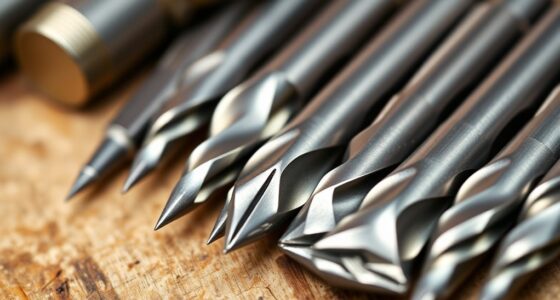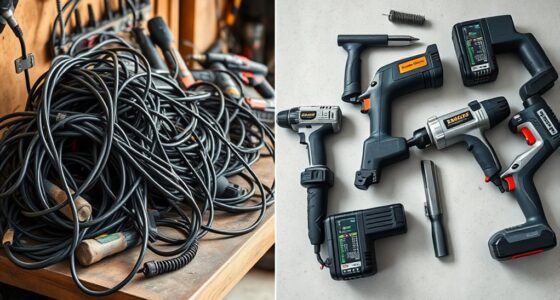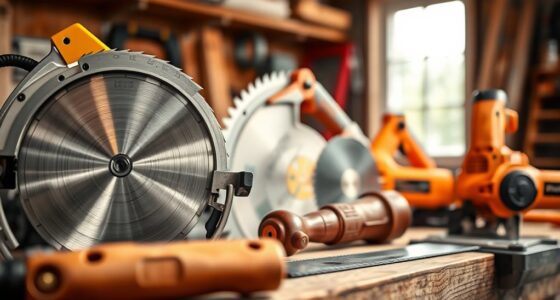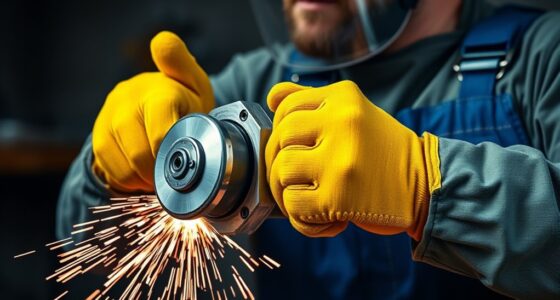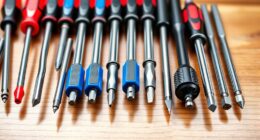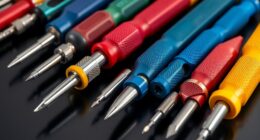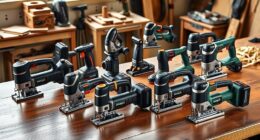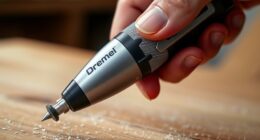When choosing a sander, consider the type, abrasive material, and power source to match your project needs. For delicate finishes or polishing, use a fine-grit orbital or detail sander. Heavy-duty tasks like paint stripping or rough sanding require coarse abrasives and more powerful tools such as belt or pneumatic sanders. Corded models work best for extended jobs, while cordless offer mobility for tight spaces. To find the perfect tool for your project, explore the different options available and how they suit your surface.
Key Takeaways
- Different sander types (orbital, belt, detail, rotary) are suited for specific tasks like finishing, heavy removal, or detailed work.
- Orbital sanders are ideal for smooth finishes on wood and light polishing tasks.
- Belt sanders excel at rapid material removal on rough surfaces and stripping paint.
- Detail sanders are perfect for tight spots, corners, and intricate surface work.
- Rotary sanders provide high power for aggressive grinding and heavy-duty applications.
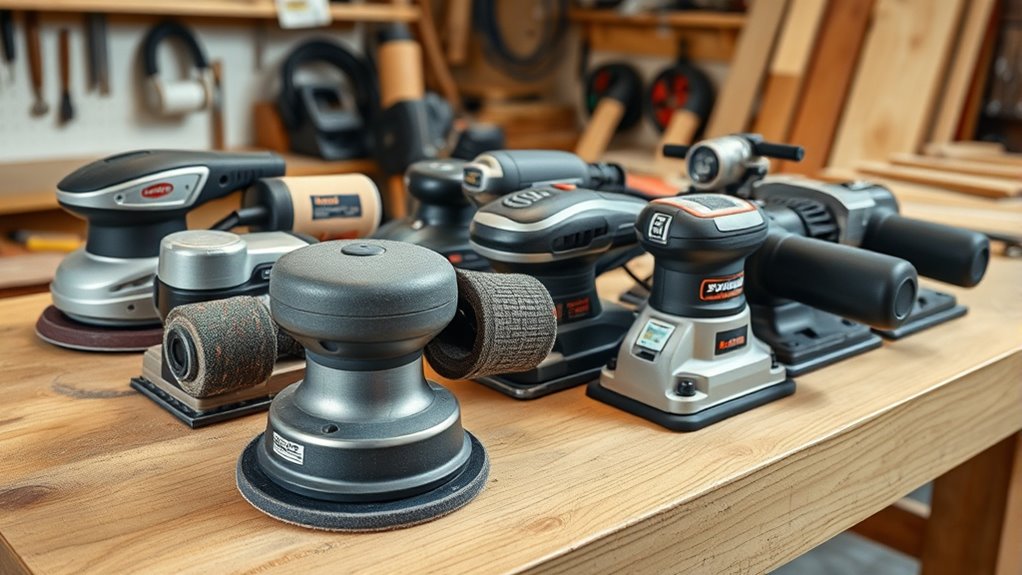
Ever wondered which sander best suits your project? The answer depends on the specific tasks you’re tackling and the type of surface you’re working with. One of the first considerations is the abrasive materials each sander uses. Different abrasives, like sandpaper, grinding discs, or polishing pads, are designed for particular materials and finishes. For example, if you’re smoothing wood, you’ll want a sander that can handle coarse to fine grit abrasives without damaging the surface. Conversely, when working on metal, you’ll need abrasives that can cut through tougher materials without overheating or gouging. The abrasive materials are fundamental because they determine the efficiency, finish quality, and durability of the sanding process.
Another key factor is the power sources that drive these tools. Sanders can be corded electric, cordless battery-powered, pneumatic (air-powered), or even manual in some cases. Electric sanders are versatile and powerful enough for most home projects, offering consistent performance and ease of use. Corded models provide continuous power, making them ideal for larger jobs where you need extended operation without worrying about battery life. Battery-powered sanders, on the other hand, offer portability and convenience, especially when working in areas without easy access to outlets. They’re perfect for quick touch-ups or projects in tight spaces. Pneumatic sanders are typically used in professional settings, providing high power and control, especially for heavy-duty tasks like sanding large surfaces or removing old paint. Manual sanders, like sanding blocks, are simple but effective for small jobs or detailed work, requiring no power at all.
Understanding the differences in abrasive materials and power sources helps you choose the right sander for your project. For light tasks, such as finishing fine furniture or polishing delicate surfaces, a small, battery-operated detail sander with fine grit abrasives works best. For more intensive work, such as stripping paint from large surfaces or sanding rough wood, an electric or pneumatic sander with coarse abrasives will get the job done faster and more efficiently. Keep in mind that the power source also impacts your mobility and comfort. Cordless models give you freedom of movement, while corded models typically offer more consistent power for extended use. Pneumatic sanders excel in professional environments where high power and durability are required for continuous work. Additionally, Kia Tuning often involves performance enhancements that can influence the type of sanding and finishing tools used for customizing vehicle surfaces.
Frequently Asked Questions
Can I Use a Detail Sander for Large Surface Projects?
You can use a detail sander for large surface sanding, but it’s not ideal. Detail sanders excel at precision work and tight spots, offering advantages like maneuverability and control. However, for large surfaces, they can be slow and inefficient. To save time and effort, consider using a larger sander like a random orbital or belt sander. These tools are designed for extensive sanding projects and provide a smoother, faster finish.
Which Sander Is Best for Removing Paint?
For removing paint, you should choose a power sander like a random orbital or belt sander. These sanders excel at stripping paint quickly and efficiently. Use proper sanding techniques to avoid damaging the surface, and always wear safety gear. For best results, follow paint removal tips such as starting with coarse grit and gradually moving to finer grits. This approach guarantees smooth, clean surfaces ready for finishing.
Are Cordless Sanders as Powerful as Corded Ones?
Cordless sanders are convenient, but they typically don’t match corded performance because of limited battery power. While advancements have improved their power, they might not handle heavy-duty tasks as efficiently as corded models. If you need consistent, strong performance for demanding projects, corded sanders are usually better. However, for lighter, quick tasks, cordless options offer portability and ease of use, making them a practical choice in many situations.
How Do I Maintain and Clean My Sander?
To maintain and clean your sander, start by unplugging it and removing dust collection bags or containers. Clean or replace filters regularly to guarantee efficient dust extraction. Use a brush or compressed air to clear dust from vents and sanding pads. Proper sanding techniques, like applying consistent pressure and avoiding overheating, help extend your sander’s life. Regular maintenance keeps dust out of your workspace and ensures peak performance.
What Safety Gear Should I Wear When Sanding?
Picture yourself facing a whirlwind of dust and debris—safety gear becomes your shield. You should wear protective clothing like goggles and a dust mask, along with respiratory protection to prevent inhaling harmful particles. These precautions aren’t just accessories; they’re your armor against dust inhalation and eye irritation. Always prioritize your safety, ensuring you’re fully protected before you start sanding, so your project stays safe and enjoyable.
Conclusion
Now that you know the different sander types, choosing the right one becomes easier. For example, if you’re refinishing a hardwood table, an orbital sander can smooth out scratches without gouging the surface. Think about your project’s needs, and pick the sander that fits best. With the right tool, you’ll achieve professional-looking results and enjoy the process even more. Happy sanding!


